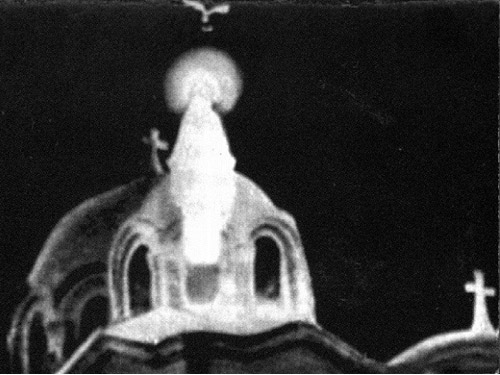
On 2 April 1968, tens of thousands of Egyptians, Muslims and Christians alike, congregated to see the Virgin Mary appear above a Coptic Orthodox Church in Zeitoun.
The dominant narrative, documented by the state-run Al-Ahram and Al-Akhbar newspapers as well as press releases by the Coptic Orthodox Church, explained that workers at a Public Transport Authority garage opposite the Zeitoun Church were the first to see the light of the Virgin Mary on the church dome.
A documentary on the event argued that never before had such a large group of people witnessed an apparition of the Virgin Mary.
The Lebanese press was the first to extensively cover the event. At first, Al-Ahram only published a few lines about people gathering by the Zeitoun Church. It was not until mid-April that Egyptian newspapers started to allocate full pages to the apparition, reporting that it lasted for over two hours.
In early May, Pope Cyril VI of Alexandria held an unprecedented news conference giving his opinion. On the following day, Al-Ahram allocated the front page to the event with the headline: “Pope Cyril announces apparition is real.”
Foreign correspondents also flooded into the country to report on the issue.
But several of interpretations were complex, paradoxical and at times illogical.
Many Egyptian and foreign experts inked opinions about the apparition. Sociologists Robert Bartholomew and Erich Goode argued in “Mass Delusions and Hysterias: Highlights from the Past Millennium” that “it appears that the [apparition] observers were predisposed by religious background and social expectation to interpreting the light displays as related to the Virgin Mary.”
Their view was among those that debunked the apparition all together. Others tried to investigate why the Virgin Mary would appear in this particular location. The answers varied with some testimonials reflecting how Egyptian society was divided, devastated and also searching for superstitions to get through.
Some argued that the Virgin Mary chose Zeitoun because of an old promise she gave to Ibrahim Khalil Pasha. The well-off Coptic man had built the Zeitoun Church instead of a planned villa.
Large swaths of people also told news reporters that this was “a sign of hope” and solace for Egyptians who were devastated after the country’s defeat in the 1967 War.
Others argued that the Virgin Mary came to Egypt to give solace to Copts who were being discriminated against at the time. That same year, a group of angry Muslims attacked a church in Luxor.
For others, the apparition was a sign that Copts will dominate the country soon, as the late anthropology professor Cynthia Nelson wrote in her paper “The Virgin of Zeitoun.”
In the years that followed, Egypt achieved a victory over Israel. But sectarian tensions and Copts’ feelings that they were oppressed and discriminated against continued to rise.
Occasionally, there are still claims of the Virgin Mary apparition in Egypt; the provided explanation has not changed: to give solace to the oppressed.



